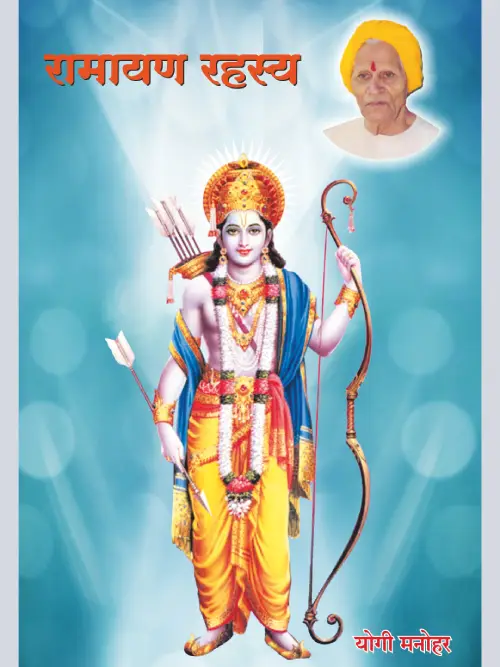
Ramayan Rahasya
Rampatra : Rampatra is the preface / foreword written to the book ‘Ramayan Rahasya’. Here, Yogiraj makes the reader aware of the fact that the Ramayana and the Mahabharata are not historical events or mythology. He explains metaphors and symbols from Ramayana methodically. He believes that these symbols are stages experienced in Yog-Sadhana and these for the betterment of mankind.
When Yogiraj was young, he had a faith that Ramayana and Mahabharata are epics of historical events. After a persistent Sadhana and getting yogic experiences beyond senses, he became a staunch believer that these epics in fact describe divine experiences achieved by Yoga. He found that many scholars who have no Yogic experience fail to understand this. Sages like Yogiraj Vasudevananda Saraswati, Mahatma Gandhi, Hon. Golvalkar Guruji and many others considered these epics not as historical events. Yogiraj Manoharji studied views of these philosophers and found that these epics are related to progressive yogic stages of a sadhak.
Yogiraj Manoharji came across a yogi who asked him, ”Ram broke Shivdhanuhsya, do you know into how many pieces?” As told by that Yogi, Yogiraji pierced his fingers at 2 places through his spinal chord (Merudanda) and witnessed that they went through breaking it into 3 pieces. Thus the yogi enlightened him that Ramayana is a symbolic epic of human life.
As a Sadhak of advanced Yoga, Yogiraj Manoharji alias Kakaji, understood the real meaning of this incident later.
Kakaji tells one more episode of Avayava-Chhedan (intersection of limbs by Yoga) by Shri Sai Baba. Shri Saibaba had attained that extrasensory yogic power of Avayava Cheddan. Kakaji tells that his devotees had witnessed it. This Yogic action is possible only to great yogis.
One of the Sadhaks /followers of Kakaji, himself experienced such an extrasensory condition during Yog-Sadhana. The epic of Ramayana is the metaphor of ideal spiritual experiences vital for life. True spiritualists must make people aware about this.
Further in the foreword, Kakaji elaborately discusses some principles of Jain and Buddhist philosophy in this light.
Metaphors from Ramayan
Ram symbolizes a Yogi-Sahdhak. He broke Shivdhanushya into pieces- this is the Avayava Chhedan of Merudanda (spinal chord). This experience can be achieved by superior Yoga practice only. Ram broke Shivdhnushya and got married to Sita (self-experience). He gave up worldly life and along with Sita (self-experience) and Laxmana (discretion/ prudence) eminent Yogi Ram lived in the forest Dandakaranya (for doing the penance of Merudanda Sadhana). After carrying out such Sadhana for 14 years with maturity and prudence, a Sadhak can become one with his soul.
Dandakaranya is a forest, where the house namely Panchvati is made of five senses. Ram cuts ears and nose of Shurpanakha (Avyava Chhedan or desire for women) and kills the golden deer i.e. covetousness. He has left his kingdom too. Thus, Ram is ready for Sadhana after giving up his all materialistic wishes. As Laxman (prudence) follows him Ram performs his Yog-Sadhana. Royal self-experience (Sita) is taken away by Brahmadnyana Ravan. When Sita, self-experience is lost, Ram becomes desperate and yearns for her. Laxman keeps his balance. The air element, Hanuman, meets Ram at Pampa Sarovar, the water element, and helps him to find out Sita. Sita is found at Brahmarup Ravan. Since Ravan has taken her away, Ram has to fight with him to get her back. This is the battle between good and evil attitudes. In this battle Ram kills Kumbhakarna who symbolizes Sadhana done by only listening. Other ill wills are also killed in this attitudinal war of Ram and Ravan. Egoistic Ravan has a son Indrajit, who has command over his limbs. Ram asks Laxman to kill Indrajit who is busy performing Yadnya. Brahmavastha is in the form of Ravan. He is egotistic as he has mastery over Vedas and knowledge. So Ram has to target his heart, meaning thereby, he has to change the mind-set totally and nurture that good attitude. Ravan is thus merged into Ram. Sita, self-experience, acquires grace of Brahmadnyan but has to go through an ordeal. Now, Sita is sacred, pure and symbolizes divine self-experience. She is also waiting to meet Ram after her stay with Brahmanubhuti. Ram and Sita and Laxman return to Ayodhya, a place where there is no war but peace. Ram symbolizes a Yogi-sadhak leading a peaceful life. Sita conceives two virtues namely Lav (time) and Kush (penance). Thus Ram achieves authority for Samdahivastha. But Story of Ramayan continues.
Order Now